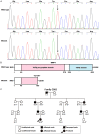Discovery and functional investigation of BMP4 as a new causative gene for human congenital heart disease
- PMID: 38883374
- PMCID: PMC11170606
- DOI: 10.62347/DGCD4269
Discovery and functional investigation of BMP4 as a new causative gene for human congenital heart disease
Abstract
Objective: Aggregating evidence highlights the strong genetic basis underpinning congenital heart disease (CHD). Here BMP4 was chosen as a prime candidate gene causative of human CHD predominantly because BMP4 was amply expressed in the embryonic hearts and knockout of Bmp4 in mice led to embryonic demise mainly from multiple cardiovascular developmental malformations. The aim of this retrospective investigation was to discover a novel BMP4 mutation underlying human CHD and explore its functional impact.
Methods: A sequencing examination of BMP4 was implemented in 212 index patients suffering from CHD and 236 unrelated non-CHD individuals as well as the family members available from the proband carrying a discovered BMP4 mutation. The impacts of the discovered CHD-causing mutation on the expression of NKX2-5 and TBX20 induced by BMP4 were measured by employing a dual-luciferase analysis system.
Results: A new heterozygous BMP4 mutation, NM_001202.6:c.318T>G;p.(Tyr106*), was found in a female proband affected with familial CHD. Genetic research of the mutation carrier's relatives unveiled that the truncating mutation was in co-segregation with CHD in the pedigree. The nonsense mutation was absent from 236 unrelated non-CHD control persons. Quantitative biologic measurement revealed that Tyr106*-mutant BMP4 failed to induce the expression of NKX2-5 and TBX20, two genes whose expression is lost in CHD.
Conclusion: The current findings indicate BMP4 as a new gene predisposing to human CHD, allowing for improved prenatal genetic counseling along with personalized treatment of CHD patients.
Keywords: BMP4; Congenital heart disease; molecular genetics; reporter gene assay; signal transduction.
AJTR Copyright © 2024.
Conflict of interest statement
None.
Figures



Similar articles
-
Identification and Functional Characterization of a Novel SOX4 Mutation Predisposing to Coffin-Siris Syndromic Congenital Heart Disease.Children (Basel). 2025 May 7;12(5):608. doi: 10.3390/children12050608. Children (Basel). 2025. PMID: 40426787 Free PMC article.
-
Discovery of BMP10 as a new gene underpinning congenital heart defects.Am J Transl Res. 2024 Jan 15;16(1):109-125. doi: 10.62347/IVRF4475. eCollection 2024. Am J Transl Res. 2024. PMID: 38322548 Free PMC article.
-
SOX17 loss-of-function variation underlying familial congenital heart disease.Eur J Med Genet. 2021 May;64(5):104211. doi: 10.1016/j.ejmg.2021.104211. Epub 2021 Mar 29. Eur J Med Genet. 2021. PMID: 33794346
-
An update on the molecular diagnosis of congenital heart disease: focus on loss-of-function mutations.Expert Rev Mol Diagn. 2017 Apr;17(4):393-401. doi: 10.1080/14737159.2017.1300062. Epub 2017 Mar 8. Expert Rev Mol Diagn. 2017. PMID: 28274167 Review.
-
NKX2-5: an update on this hypermutable homeodomain protein and its role in human congenital heart disease (CHD).Hum Mutat. 2010 Nov;31(11):1185-94. doi: 10.1002/humu.21345. Epub 2010 Oct 12. Hum Mutat. 2010. PMID: 20725931 Review.
Cited by
-
Identification and Functional Investigation of SOX4 as a Novel Gene Underpinning Familial Atrial Fibrillation.Diagnostics (Basel). 2024 Oct 25;14(21):2376. doi: 10.3390/diagnostics14212376. Diagnostics (Basel). 2024. PMID: 39518344 Free PMC article.
-
Identification and Functional Characterization of a Novel SOX4 Mutation Predisposing to Coffin-Siris Syndromic Congenital Heart Disease.Children (Basel). 2025 May 7;12(5):608. doi: 10.3390/children12050608. Children (Basel). 2025. PMID: 40426787 Free PMC article.
References
-
- Tsao CW, Aday AW, Almarzooq ZI, Anderson CAM, Arora P, Avery CL, Baker-Smith CM, Beaton AZ, Boehme AK, Buxton AE, Commodore-Mensah Y, Elkind MSV, Evenson KR, Eze-Nliam C, Fugar S, Generoso G, Heard DG, Hiremath S, Ho JE, Kalani R, Kazi DS, Ko D, Levine DA, Liu J, Ma J, Magnani JW, Michos ED, Mussolino ME, Navaneethan SD, Parikh NI, Poudel R, Rezk-Hanna M, Roth GA, Shah NS, St-Onge MP, Thacker EL, Virani SS, Voeks JH, Wang NY, Wong ND, Wong SS, Yaffe K, Martin SS American Heart Association Council on Epidemiology and Prevention Statistics Committee and Stroke Statistics Subcommittee. Heart disease and stroke statistics-2023 update: a report from the American Heart Association. Circulation. 2023;147:e93–e621. - PubMed
-
- Zhao Y, Deng W, Wang Z, Wang Y, Zheng H, Zhou K, Xu Q, Bai L, Liu H, Ren Z, Jiang Z. Genetics of congenital heart disease. Clin Chim Acta. 2024;552:117683. - PubMed
LinkOut - more resources
Full Text Sources
